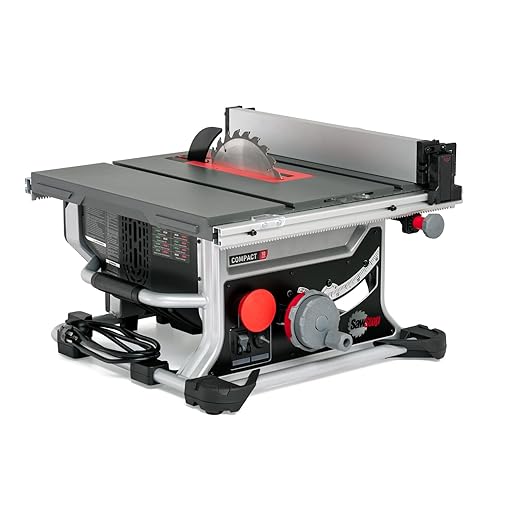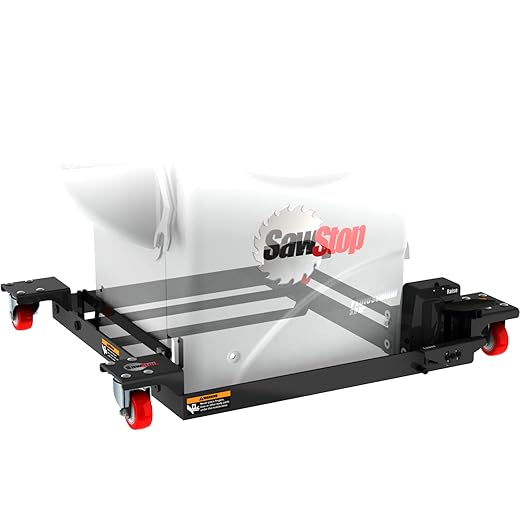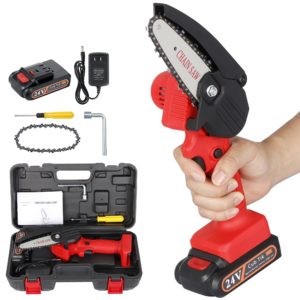SawStop is a pioneering technology in the field of power tools, specifically table saws. It was invented by Stephen Gass, a patent attorney and woodworking enthusiast, who sought to address the serious issue of table saw accidents and severe injuries. The SawStop system is designed to prevent or minimize injuries by using an innovative electronic sensing mechanism that can detect when a user’s finger or hand comes into contact with the saw blade.
The key feature of SawStop is its ability to detect the difference in electrical capacitance between wood and human flesh. When a person’s finger or hand touches the spinning saw blade, the system immediately triggers and activates a braking mechanism. The blade comes to a complete stop within milliseconds, preventing severe injuries and reducing the severity of cuts.
What sets SawStop apart from conventional table saws is its proactive approach to safety. Traditional table saws rely on physical guards and user caution, but accidents can still occur. SawStop takes a more advanced approach by combining technology with safety measures, significantly reducing the risk of life-altering accidents.
SawStop has gained recognition and acclaim within the woodworking industry for its effectiveness in preventing table saw injuries. Its technology has been widely adopted by professionals and enthusiasts alike who prioritize safety in their woodworking practices. As a result, SawStop has had a substantial impact on promoting safer working environments and preventing serious accidents associated with table saw use.
Can you put a SawStop on any table saw?
SawStop technology is primarily available as a built-in feature in table saws manufactured by SawStop themselves. These table saws come equipped with the SawStop safety system integrated into their design. The technology is not available as a retrofit kit or an aftermarket addition for existing table saws.
SawStop table saws are specifically engineered to incorporate the necessary components, such as the electronic sensing mechanism and braking system, to provide the safety features offered by SawStop. The integration of this technology requires careful design and construction to ensure proper functionality and effectiveness.
If you’re interested in equipping your workshop with SawStop safety features, you would typically need to purchase a table saw from SawStop or consider replacing your current table saw with a SawStop model. These specialized table saws are designed to provide enhanced safety measures and reduce the risk of serious injuries associated with table saw use.
Can you cut wet wood with SawStop?
It is generally not recommended to cut wet wood with any table saw, including a SawStop. Wet wood has a higher moisture content, which can affect the performance of the saw and potentially compromise safety. Here are a few reasons why cutting wet wood with a table saw, including a SawStop, is not advisable:
- Blade Performance: Wet wood is softer and tends to be more prone to tear-out and splintering. This can put additional strain on the blade and affect its cutting performance. Wet wood may also cause more significant wear and tear on the blade, reducing its lifespan.
- Electrical Safety: Wet wood increases the risk of electrical hazards when using power tools, including table saws. The moisture in the wood can create a better conductor for electricity, potentially increasing the chances of short circuits or electrical shocks.
- Rust and Corrosion: Cutting wet wood exposes the table saw’s components, including the blade and other metal parts, to moisture. This can lead to rust and corrosion, which can negatively impact the longevity and functionality of the saw.
- Increased Kickback Risk: Wet wood can be more challenging to control during cutting due to its higher moisture content and reduced structural integrity. This increases the risk of kickback, where the wood is forcefully propelled back toward the user. Kickback incidents can cause severe injuries.
If you need to work with wet wood, it is generally recommended to allow it to dry thoroughly before cutting it with any table saw. This helps ensure better cutting performance, reduces safety risks, and minimizes potential damage to the saw and its components.
What materials Cannot be cut on the SawStop table saw?
The SawStop table saw is primarily designed for cutting wood and wood-based materials. While it can handle a wide range of materials commonly used in woodworking, there are certain materials that are not suitable for cutting on a SawStop table saw. These include:
- Non-Conductive Materials: The SawStop safety system relies on the detection of electrical capacitance changes to trigger the braking mechanism. Therefore, materials that are non-conductive or have very low conductivity may not be recognized by the system. Examples of such materials include plastics, glass, stone, ceramics, and non-ferrous metals like aluminum or copper.
- Wet or Damp Materials: Cutting wet or damp materials, regardless of their conductivity, is generally not recommended on any table saw, including SawStop. Wet wood or other materials can affect the performance of the blade, increase the risk of kickback, and potentially compromise safety.
- Excessively Thick or Hard Materials: The SawStop table saw is designed for cutting wood and wood-based materials of typical thicknesses encountered in woodworking projects. Excessively thick or extremely hard materials, such as dense hardwoods or metals, may put excessive strain on the saw’s motor, blade, and braking mechanism, potentially leading to reduced performance or damage.
It’s important to refer to the manufacturer’s guidelines and recommendations provided with your specific SawStop table saw to determine the appropriate materials for cutting. If you have specific materials or projects in mind that deviate from typical woodworking applications, it’s advisable to consult the manufacturer or seek professional advice to ensure safe and appropriate usage.
How does a sawstop work?
The SawStop system is designed to prevent or minimize injuries by quickly stopping the rotation of the saw blade when it detects contact with a conductive material, such as flesh. Here’s a simplified explanation of how SawStop works:
- Capacitive Sensing: The SawStop system uses capacitive sensing technology. It generates a low-level electrical signal and creates an electric field around the saw blade.
- Detection of Conductive Material: When a conductive material, such as a finger, enters the electric field and makes contact with the spinning blade, the electrical capacitance of the system changes.
- Rapid Detection and Activation: The SawStop system continuously monitors the electrical capacitance. When there is a sudden and significant change in capacitance, indicating contact with a conductive object, the system recognizes it as a potential danger.
- Activation of Braking Mechanism: Once contact with a conductive material is detected, the SawStop system triggers the activation of the braking mechanism. This mechanism quickly stops the rotation of the blade, preventing further contact and reducing the severity of potential injuries.
- Aluminum Brake Pawl: The braking mechanism consists of an aluminum brake pawl that is driven into the teeth of the spinning blade. The force exerted by the brake pawl rapidly brings the blade to a complete stop.
- Damage Mitigation: As the blade stops, it retracts and drops below the table surface, minimizing the depth of the cut and reducing the risk of severe injuries.
It’s important to note that once the SawStop system is activated, the blade, the aluminum brake pawl, and other components are damaged and need to be replaced. This ensures that the system is ready to respond effectively in case of future incidents.
The SawStop system is highly regarded for its effectiveness in preventing severe injuries associated with table saw use. By combining capacitive sensing technology with a rapid braking mechanism, SawStop aims to provide an added layer of safety and protect users from potentially life-altering accidents.
How does SawStop recognize a finger?
SawStop recognizes a finger or any other conductive material, such as a hand, by utilizing capacitive sensing technology. The system is designed to detect changes in electrical capacitance when a conductive object, like flesh, comes into contact with the spinning saw blade. Here’s a simplified explanation of how SawStop recognizes a finger:
- Capacitive Sensing: The SawStop system generates a low-level electrical signal and creates an electric field around the saw blade. This electric field extends slightly above the surface of the blade.
- Electrical Capacitance: When a conductive object, such as a finger, enters the electric field, it alters the capacitance of the system. The presence of the conductive material (flesh) causes a change in the electrical capacitance of the system.
- Rapid Change Detection: The SawStop system continuously monitors the electrical capacitance. When there is a sudden and significant change in capacitance, indicating that a conductive object has made contact with the blade, the system quickly recognizes it as a potential danger.
- Activation and Brake Engagement: Once the system detects the rapid change in capacitance, it triggers the activation of the braking mechanism. The braking mechanism promptly stops the blade’s rotation by driving an aluminum brake pawl into the blade’s teeth, preventing further contact and minimizing the severity of the injury.
In summary, the SawStop system uses capacitive sensing technology to detect the presence of conductive materials, such as a finger, by monitoring changes in electrical capacitance. This innovative approach allows the system to recognize contact with a conductive object and initiate the necessary safety measures to prevent severe injuries.
How does a SawStop know when to stop?
SawStop uses an innovative electronic sensing system to detect when a person’s finger or hand comes into contact with the saw blade, triggering the mechanism to stop the blade’s rotation. Here’s a simplified explanation of how it works:
- Capacitive Sensing: The SawStop system utilizes capacitive sensing, which means it measures changes in electrical capacitance. When a person touches the saw blade, their body’s electrical capacitance alters the electrical field around the blade.
- Detection Circuit: The SawStop table saw has a detection circuit built into the arbor assembly, located beneath the saw’s tabletop. This circuit consists of a small electrical signal generator and a detection electrode.
- Continuous Monitoring: The detection circuit continuously monitors the electrical capacitance of the saw blade. When a finger or hand makes contact with the blade, the capacitance increases significantly due to the presence of human tissue.
- Activation of Brake: When the detection circuit senses a rapid change in capacitance indicating contact with flesh, it triggers the activation of the braking mechanism.
- Brake Activation: The braking mechanism consists of an aluminum brake pawl and a spring-loaded activation cartridge. When triggered, the activation cartridge drives the aluminum brake pawl into the teeth of the spinning blade, bringing it to a stop within milliseconds.
- Damage Mitigation: As the brake engages, the blade’s momentum drives it downward into the table, causing it to retract and minimizing the depth of the cut. This action helps reduce the severity of injuries and prevents more severe damage to the user.
It’s important to note that after the activation of the braking mechanism, the saw blade becomes damaged and will need to be replaced, along with the activation cartridge and other components. This is a trade-off to prevent serious injuries and ensure the system is ready to respond to any future incidents.
Overall, the SawStop system combines capacitive sensing, detection circuitry, and a rapid brake activation mechanism to detect and prevent accidents, providing an extra layer of safety for users.
Is a SawStop worth the price?
The question of whether a SawStop is worth the price ultimately depends on individual circumstances and priorities. Here are some factors to consider:
- Safety: SawStop is widely regarded as a highly effective safety feature for table saws. It has a proven track record of preventing severe injuries by quickly stopping the blade when contact with flesh is detected. If safety is a top priority for you, investing in a SawStop-equipped table saw can provide peace of mind and significantly reduce the risk of life-altering accidents.
- Cost of Accidents: Table saw accidents can result in devastating injuries and financial burdens due to medical expenses, rehabilitation, and potential loss of income. The cost of a SawStop-equipped table saw may seem high initially, but when compared to the potential costs of an accident, it can be seen as a worthwhile investment.
- Professional Use: If you rely on a table saw for your profession, such as woodworking or carpentry, the added safety of a SawStop could be particularly valuable. It can help protect your livelihood by minimizing the risk of injuries that could lead to downtime, medical expenses, or legal complications.
- Budget Constraints: SawStop-equipped table saws generally come at a higher price point compared to conventional table saws. If budget is a significant concern and you have alternative safety measures in place, such as vigilant use of blade guards and push sticks, you may need to evaluate whether the added cost is feasible for you.
Ultimately, it’s important to assess your own needs, budget, and the value you place on safety when deciding whether a SawStop-equipped table saw is worth the price for you. Considering the potential long-term benefits and the added layer of protection it provides, many users find that the investment in a SawStop is justified for the enhanced safety it offers.
Is a SawStop reusable?
No, the SawStop system is not reusable after it has been triggered. Once the system is activated and the blade comes to a stop, several components of the system, including the blade, the activation cartridge, and the aluminum brake pawl, are damaged and need to be replaced.
When the brake engages, it drives the aluminum brake pawl into the teeth of the spinning blade, causing it to stop. This action not only stops the blade but also damages both the brake pawl and the teeth of the blade. Additionally, the activation cartridge is designed to absorb the impact and prevent the blade from spinning again.
After a SawStop activation, the blade, activation cartridge, and brake pawl must be replaced to restore the table saw to its operational state. This replacement is necessary to ensure the system is ready to respond effectively in case of future incidents. While replacing these components incurs additional costs, it is a trade-off for the safety benefits provided by the SawStop system.
It’s worth noting that the SawStop system is designed to prioritize safety over reusability, as its primary goal is to prevent severe injuries.
Does SawStop prevent kickback?
While SawStop is primarily designed to prevent or minimize severe injuries caused by contact with the spinning blade, it does not specifically target or prevent kickback incidents. Kickback refers to the sudden and forceful movement of the workpiece backward, towards the user, often caused by the binding, pinching, or improper alignment of the material being cut.
SawStop’s main focus is on the safety aspect of preventing contact with the blade, triggering the braking mechanism, and minimizing the severity of injuries in case of accidental contact. However, the system does not have a specific mechanism or feature dedicated to preventing kickback incidents.
To mitigate the risk of kickback when using any table saw, including one equipped with SawStop technology, it is essential to follow proper safety practices, such as:
- Using a riving knife or splitter: These are accessories that help prevent the workpiece from binding and reduce the likelihood of kickback by keeping the kerf open.
- Using anti-kickback pawls: These are additional attachments that can help prevent the workpiece from moving backward during a kickback incident.
- Maintaining proper blade alignment and sharpness: A well-aligned blade and a sharp cutting edge can contribute to smoother and safer cutting, reducing the likelihood of binding and kickback.
- Using appropriate feeding techniques: Employing proper feeding techniques, such as using a push stick or push block, can help maintain control over the workpiece and reduce the chances of kickback.
It’s important to familiarize yourself with and adhere to the safety guidelines and recommendations provided by the saw manufacturer and to practice proper usage techniques to minimize the risk of kickback incidents when operating a table saw, including one equipped with SawStop technology.
Does SawStop brake the saw?
Yes, the SawStop system is designed to brake the saw blade when contact with a conductive object, such as a finger, is detected. The braking mechanism is a crucial part of the SawStop safety system and is responsible for rapidly stopping the rotation of the blade to prevent severe injuries. Here’s an overview of how the braking process works:
- Contact Detection: When a conductive object, like a finger, comes into contact with the spinning blade, the SawStop system quickly detects the change in electrical capacitance caused by this contact.
- Activation Signal: Once the system recognizes the presence of a conductive object, it triggers an activation signal to engage the braking mechanism.
- Brake Engagement: The braking mechanism consists of an aluminum brake pawl and a spring-loaded activation cartridge. When the activation signal is sent, the activation cartridge releases the brake pawl, driving it into the teeth of the spinning blade.
- Rapid Blade Stop: As the brake pawl makes contact with the blade’s teeth, it exerts significant force, causing the blade to rapidly come to a stop within milliseconds. This immediate stopping action helps prevent further contact and reduces the severity of any potential injury.
It’s important to note that once the SawStop system is activated, the blade, the aluminum brake pawl, and the activation cartridge are damaged and need to be replaced to restore the table saw to its operational state. This is a trade-off to ensure that the system is ready to respond effectively to any future incidents and provide ongoing safety protection.
The braking process of SawStop is a key feature that sets it apart from conventional table saws, as it offers an additional layer of safety to minimize the risk of severe injuries when accidental contact with the blade occurs.
Factors to consider when sawstop table saw?
When considering a SawStop table saw, there are several important factors to take into account. These factors will help you make an informed decision based on your specific needs and requirements. Here are some key considerations:
- Safety Features: SawStop table saws are renowned for their safety features, particularly the ability to prevent severe injuries by stopping the blade when contact with flesh is detected. However, it’s essential to understand the specific safety features offered by the model you are considering, such as blade guard systems, emergency stop buttons, and additional safety mechanisms.
- Budget: SawStop table saws are generally priced higher compared to conventional table saws due to their advanced safety technology. Set a budget range that you are comfortable with and explore the SawStop models that fall within that range. It’s important to weigh the cost against the value of enhanced safety features.
- Intended Use: Consider your specific woodworking needs and projects. Determine the size and power requirements of the table saw based on the materials you work with and the scale of your projects. SawStop offers a range of table saw models, each with different features, sizes, and capabilities to suit various user needs.
- Accuracy and Precision: Assess the accuracy and precision of the table saw’s cutting capabilities. Look for features such as smooth fence adjustments, stable and precise miter gauge systems, and the ability to make fine adjustments to the blade height and angle. These factors contribute to achieving accurate and clean cuts.
- Durability and Build Quality: Evaluate the overall build quality and durability of the table saw. Look for sturdy construction, quality materials, and components that can withstand heavy use over time. A durable table saw will provide longevity and reliability in your woodworking projects.
- Additional Features and Accessories: Consider any additional features and accessories that may enhance your woodworking experience. This can include features like dust collection systems, mobile bases, extension tables, and compatibility with various blades and attachments.
- User Reviews and Feedback: Take the time to research and read user reviews and feedback on the specific SawStop model you are interested in. Real-world experiences from other users can provide valuable insights into the performance, reliability, and overall satisfaction with the table saw.
By considering these factors, you can narrow down your options and select the SawStop table saw that best aligns with your safety requirements, budget, woodworking needs, and desired features.
How long does sawstop table saws last?
The lifespan of a SawStop table saw can vary depending on various factors, including frequency of use, maintenance, and the specific model. However, with proper care and regular maintenance, a SawStop table saw can last for many years.
The durability and longevity of a SawStop table saw can be influenced by several factors:
- Build Quality: SawStop is known for producing high-quality table saws. The materials used, construction methods, and overall build quality contribute to the durability and longevity of the saw. Higher-end models generally feature sturdier components and construction.
- Maintenance: Regular maintenance is essential to ensure optimal performance and longevity. This includes proper cleaning, lubrication of moving parts, blade alignment, and replacing worn-out components when necessary. Following the manufacturer’s maintenance guidelines and recommendations will help extend the lifespan of the table saw.
- Intensity of Use: The frequency and intensity of use can affect the lifespan of any power tool, including a table saw. Heavy and continuous use may lead to more wear and tear on the components. However, SawStop table saws are designed to withstand demanding work environments, making them suitable for professional use.
- Replacement Parts Availability: The availability of replacement parts is also a factor to consider. Over time, some components may wear out and require replacement. SawStop’s commitment to customer support and their network of authorized service centers ensure that replacement parts are readily available for their table saws.
It’s important to note that the SawStop safety system, including the brake cartridge and brake pawl, is designed to be single-use. Once the system is triggered, these components need to be replaced to restore the table saw’s safety features.
While specific guarantees or warranties may be provided by the manufacturer, the actual lifespan of a SawStop table saw can vary based on the factors mentioned above. With proper care, maintenance, and responsible usage, a well-maintained SawStop table saw can serve you for many years of safe and reliable woodworking.
Do you really need a sawstop table saw?
Whether or not you need a SawStop table saw depends on your individual circumstances, priorities, and risk tolerance. Here are some considerations to help you make an informed decision:
- Safety Priority: If safety is your top priority and you want to minimize the risk of severe injuries associated with table saw use, a SawStop table saw can provide an added layer of safety. The technology is designed to detect contact with flesh and rapidly stop the blade, potentially preventing life-altering accidents. If safety is a paramount concern for you, investing in a SawStop table saw may align with your priorities.
- Risk Assessment: Consider the nature of your woodworking projects, your level of experience, and the potential risks involved. If you frequently work with power tools, especially table saws, and handle larger or more complex projects, the risk of accidents may be higher. In such cases, having a table saw with enhanced safety features like SawStop can be beneficial in mitigating potential risks.
- Regulatory Requirements: In some professional settings or educational institutions, there may be specific safety regulations or insurance requirements that mandate the use of table saws equipped with advanced safety features like SawStop. If you fall under such requirements, a SawStop table saw may be necessary to comply with regulations and ensure a safe working environment.
- Budget Constraints: It’s important to consider your budget when evaluating whether a SawStop table saw is necessary. SawStop table saws are generally priced higher compared to conventional table saws due to the advanced safety technology. If your budget is limited and you have alternative safety measures in place, such as vigilant use of blade guards and push sticks, you may need to assess whether the added cost is feasible for you.
- Alternative Safety Measures: It’s worth noting that there are other safety measures you can implement, such as using blade guards, push sticks, and practicing safe cutting techniques, to reduce the risk of accidents on a conventional table saw. While these measures do not offer the same level of automatic blade-stopping capability as SawStop, they can still contribute to a safer working environment.
Ultimately, the decision of whether you really need a SawStop table saw depends on your personal circumstances, priorities, and risk assessment. It’s important to evaluate the potential benefits, costs, and level of safety required for your woodworking projects to determine if a SawStop table saw is the right fit for you.
You May Also Like These Deals!
What can mini cordless chainsaw cut?
A mini cordless chainsaw is a compact and portable cutting...
Read MoreBest Miter Saw Black Friday Deals
Many people’s first woodworking machine purchase is a miter saw,...
Read MoreBest Table Saw Black Friday Deals
Table saws can be used for a variety of professional...
Read MoreBest Chainsaw Black Friday Deals
If you’re in the market for a new chainsaw, then...
Read MoreProducts recommended in the post contain affiliate links. We may receive a commission when you buy something through our posts.
Why Trust Us
You will find what you are looking for at Black Friday Weeks. From classic to luxury brands, you'll find both. We will help you to select appliances that fit your needs, budget and lifestyle. Whether you want to stop by to learn more — or plan to make a major purchase — we’ll treat you like family and assist you every step of the way. Shop with us today to receive friendly and experienced help along the way.















